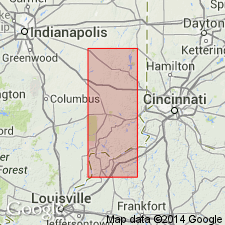
- Usage in publication:
-
- Waynesville beds
- Modifications:
-
- Named
- Dominant lithology:
-
- Limestone
- Clay
- AAPG geologic province:
-
- Cincinnati arch
Summary:
Waynesville or BYTHOPORA MEEKI beds described as dove-colored to blue limestones, interbedded with blue or greenish-blue clay. 50 ft thick. Conformably overlies Warren beds [Arnheim formation] and underlies Liberty beds. Assigned to Richmond group. Age is Late Ordovician.
Source: GNU records (USGS DDS-6; Reston GNULEX).

- Usage in publication:
-
- Waynesville shale/limestone
- Modifications:
-
- Overview
- Areal extent
- AAPG geologic province:
-
- Cincinnati arch
Summary:
Waynesville shale adopted by U.S. Geological Survey to exclude at base, beds called by A.F. Foerste, Fort Ancient division of Waynesville, which according to E.O. Ulrich and C. Butts more appropriately belong to underlying Arnheim shale. In introducing Fort Ancient, Foerste also stated that the lamellibranchs suggest that Fort Ancient belongs to Arnheim. In his subsequent reports, however, he included it in Waynesville and placed an unconformity at its base. According to E.O. Ulrich and C. Butts there is an unconformity at top of Fort Ancient of Foerste. In southwestern OH, the Waynesville is chiefly shale and is called Waynesville shale; in southern IN and north-central KY, it is chiefly limestone and is called Waynesville limestone.
Source: GNU records (USGS DDS-6; Reston GNULEX).

- Usage in publication:
-
- Waynesville formation
- Modifications:
-
- Not used
- AAPG geologic province:
-
- Cincinnati arch
Summary:
Tanners Creek Formation (new) replaces Arnheim, Waynesville, and Liberty Formations, which are based on paleontologic criteria and are lithologically indistinguishable.
Source: GNU records (USGS DDS-6; Reston GNULEX).

- Usage in publication:
-
- Waynesville Formation
- Modifications:
-
- Revised
- AAPG geologic province:
-
- Cincinnati arch
Summary:
The Geological Survey of Ohio recognizes the Cincinnati Group proposed by Meek and Worthen (1865), but at this time retains it as an informal term. The unit will be formally reinstated as a lithostratigraphic term after revision of its lower boundary and minor lithologic redescription of its units are completed. The ten formations included in the group are the (ascending) Clays Ferry Formation, the Kope Formation, the Fairview Formation, the Miamitown Shale, the Grant Lake Limestone, the Arnheim Formation, the Waynesville Formation, the Liberty Formation, the Whitewater Formation, and the Drakes Formation. Six members have been identified in the course of field mapping: the Point Pleasant Tongue of the Clays Ferry, the informal Bellevue, Corryville, Mount Auburn, and Straight Creek members of the Grant Lake Limestone, and the Preachersville Member of the Drakes Formation. The Backbone Creek and Elk Creek beds are recognized as excellent stratigraphic marker beds.
Source: GNU records (USGS DDS-6; Reston GNULEX).

- Usage in publication:
-
- Waynesville Formation*
- Modifications:
-
- Overview
- Age modified
- AAPG geologic province:
-
- Cincinnati arch
Summary:
Used as Waynesville Formation in OH. Age refined to Cincinnatian (Richmondian).
Source: GNU records (USGS DDS-6; Reston GNULEX).
For more information, please contact Nancy Stamm, Geologic Names Committee Secretary.
Asterisk (*) indicates published by U.S. Geological Survey authors.
"No current usage" (†) implies that a name has been abandoned or has fallen into disuse. Former usage and, if known, replacement name given in parentheses ( ).
Slash (/) indicates name conflicts with nomenclatural guidelines (CSN, 1933; ACSN, 1961, 1970; NACSN, 1983, 2005, 2021). May be explained within brackets ([ ]).

